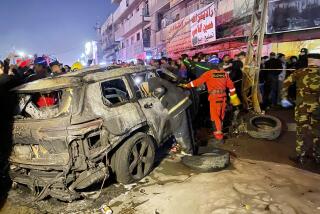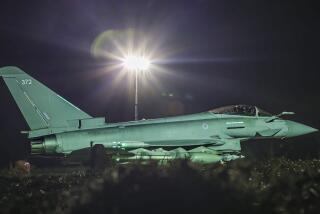Iraq massacre reported as U.S. strikes target militants at Mosul dam
In a significant expansion of the air campaign in Iraq, U.S. warplanes and armed drones launched airstrikes Saturday near the Mosul dam in the first joint operation with Iraqi and Kurdish ground forces attempting to retake the strategic northern facility from Islamist militants, U.S. officials said.
The attacks came amid new reports of a massacre of minority Yazidis for which Iraqi officials blamed the militants.
Two days after the resignation of controversial Prime Minister Nouri Maliki, which U.S. officials said cleared the way for greater military assistance to Iraq, American warplanes carried out several attacks to offer cover for Iraqi soldiers and Kurdish pro-government peshmerga fighters trying to regain control of Iraq’s largest hydroelectric facility, a U.S. official said.
U.S. Central Command said in a statement that warplanes had conducted nine airstrikes Saturday near the dam and the city of Irbil, the heaviest day of attacks since the air campaign began, destroying or damaging “four armored personnel carriers, seven armed vehicles, two Humvees and an armored vehicle.”
U.S. officials said the operation, which stretched by hundreds of miles the geographic area where U.S. warplanes are attacking, did not stray beyond the limits President Obama has placed on military action in Iraq. Obama has repeatedly said such action would be limited to protecting American personnel, preventing “genocide” and providing humanitarian aid.
It is “supportive of both the humanitarian mission and of the need to protect U.S. personnel due to the damage that could be wrought from their control of the dam,” said one official. “We’ve talked about protecting critical infrastructure before.”
A second U.S. official said no U.S. forces were on the ground near the dam. The officials asked not to be identified while discussing military operations.
The stepped-up air campaign has buoyed the spirits of Iraq’s mostly northern-based Kurdish population, whose political leaders have longtime links to U.S. officials, and of other Iraqi ethnic minorities who feel targeted by the marauding Islamic State extremist group.
Reports emerged Saturday of a new massacre by the militants against members of the minority Yazidi sect, whose encirclement by Islamic State forces atop remote Mt. Sinjar prompted Obama to begin the airstrikes early this month. Iraqi officials said militants entered a Yazidi village near the mountain range Friday and killed scores of men, then took hundreds of women and children captive.
The militants had surrounded the village of Kocho for several days and given the Yazidis, whom they consider heretics, a deadline for converting to Islam, said Mahma Khalil, a Yazidi lawmaker. Khalil cited accounts by two survivors who feigned death, then fled to safety.
The village contained about 300 men, but it was not immediately clear how many were killed. Iraqi news agencies reported that at least 81 died. About 600 women and children from the village have been taken to the town of Tall Afar, which is under the control of the militant group, Khalil said.
The information could not be immediately verified because the area is inaccessible to journalists.
The U.S. bombing campaign around the mountain helped facilitate the escape of tens of thousands of Yazidis, but others are holed up in the mountains or in surrounding villages like Kocho where they are still threatened by the militants.
Obama has said the airstrikes and airdrops of humanitarian aid broke the “siege of Mt. Sinjar.” But Iraqi officials said the attack in Kocho, about 10 miles from the mountain area, showed that the risk remained high for the Yazidis, an ancient sect ethnically linked to the Kurds.
“When President Obama said in his statement that things were stable for the Yazidis, this is not true,” Khalil said.
Peshmerga forces also were reportedly preparing to launch a ground assault aimed at retaking the town of Sinjar, whose capture by militants sparked the harrowing exodus this month of thousands of Yazidis through the mountain highlands.
The bombing campaign has aided Kurdish forces, including militiamen from Syria and Turkey, who have taken control of much of the 30-mile-long mountain range. The Kurdish fighters have also opened a corridor to the Syrian Kurdish zone for Yazidis and others fleeing the Islamic State, whose fighters have seized much of northern and western Iraq.
“We were very pleased to see the Americans get involved,” said Ziab Zuber, a commander with the Kurdish peshmerga forces at a checkpoint outside the town of Gwer, near Irbil, the capital of the semiautonomous Kurdish region. “We need more aircraft and heavier weapons in this fight.”
Yet the air campaign has both advantages and limitations, experts say.
In the flat, open terrain prevalent in much of northern Iraq, aerial bombardment can easily hit fixed militant positions and mechanized units. But it is less effective in urban areas such as Mosul and Tall Afar, where Islamic State fighters mingle among the population.
Sunni Arab activists have already accused the Iraqi military of indiscriminate bombing of civilian areas in Mosul and Tikrit, another militant-held city. Washington is aware that civilian casualties from airstrikes could cement bonds between the Islamic State and Sunni Arab communities, dashing hope for a Sunni uprising against the extremists like that seen during the U.S. occupation of Iraq that ended in 2011.
Whether Kurdish ground forces can expel the Islamic State from Sinjar and other areas, however, remains to be seen. Kurdish officials readily concede that they are outgunned by the extremists, flush with weapons seized from the Iraqi army, including U.S.-made armored Humvees.
Islamic State fighters seized Gwer and a nearby town, Makhmour, on Aug. 7, causing a near-panic 25 miles away in Irbil, a thriving city of more than 1.5 million. Kurdish troops beat an embarrassing retreat from the two towns as the militants advanced, raising questions about the abilities of the once vaunted peshmerga forces.
“The tragedy started from there, when the leaders of the peshmerga withdrew without fighting,” said Mahmoud Othman, an independent Kurdish politician. “That is a big crime.”
The Islamic State pulled back from Gwer and Makhmour on Aug. 10 amid a Kurdish counteroffensive helped by U.S. and Iraqi airstrikes, Kurdish commanders said.
The militants still hold much of the Mosul dam area, which includes a 40-mile-long lake along the Tigris River and is the source of water and electricity for a vast area of northern Iraq. In the worst-case scenario, U.S. officials worry that the militants will open or destroy the dam, flooding towns and cities downstream.
But the main casualty of such action would be the city of Mosul, about 30 miles away, which is the militants’ main stronghold in Iraq and home to a mainly Sunni Muslim population.
In Irbil, long a bastion of stability in crisis-ridden Iraq, life has returned to normal since the threat of a militant thrust toward the city has abated. But the city, like others, has absorbed a massive influx of displaced families, mostly from minority groups who view a Western offensive against the militants as their only chance to return to their ancestral homes.
“The Americans must help us; it is the only way to drive off these terrorists,” said Moussa Berri Abbas, 47, one of 20,000 Yazidis who sought shelter at the desolate Bajed Kandala camp in northern Iraq near the Syrian border.
“We need help from America, from Europe. We are peaceful people and do not have an army to fight against these killers.”
Bengali reported from Baghdad, Cloud from Washington and McDonnell from Irbil.Follow news out of Iraq on Twitter at @SBengali, @mcdneville and @DavidCloudLAT.
More to Read
Start your day right
Sign up for Essential California for news, features and recommendations from the L.A. Times and beyond in your inbox six days a week.
You may occasionally receive promotional content from the Los Angeles Times.







